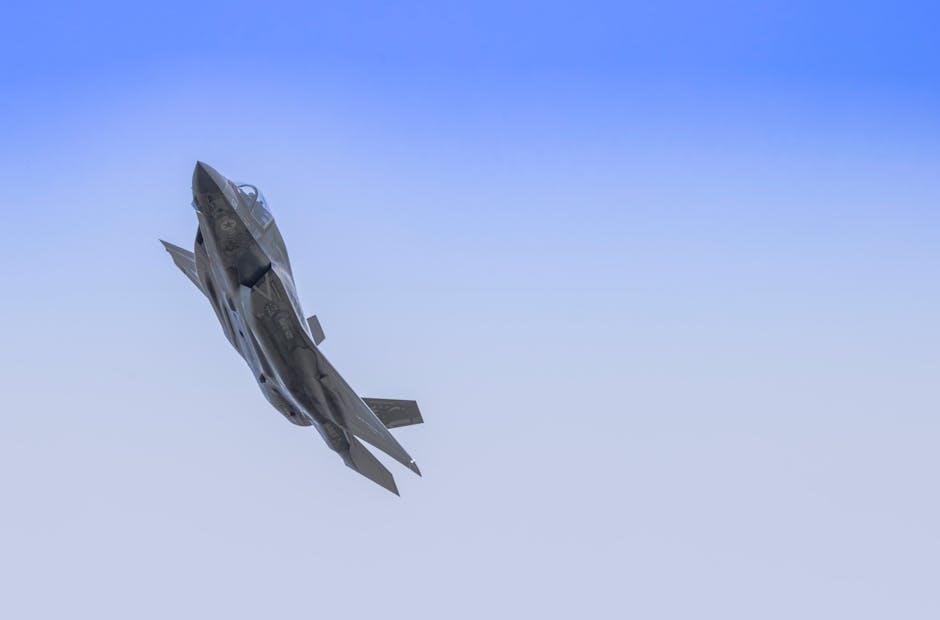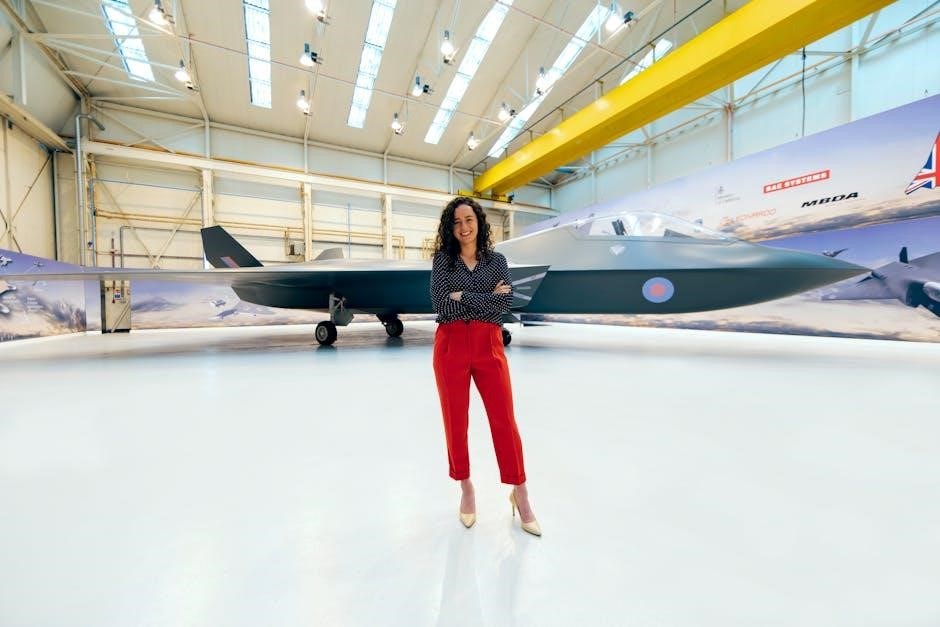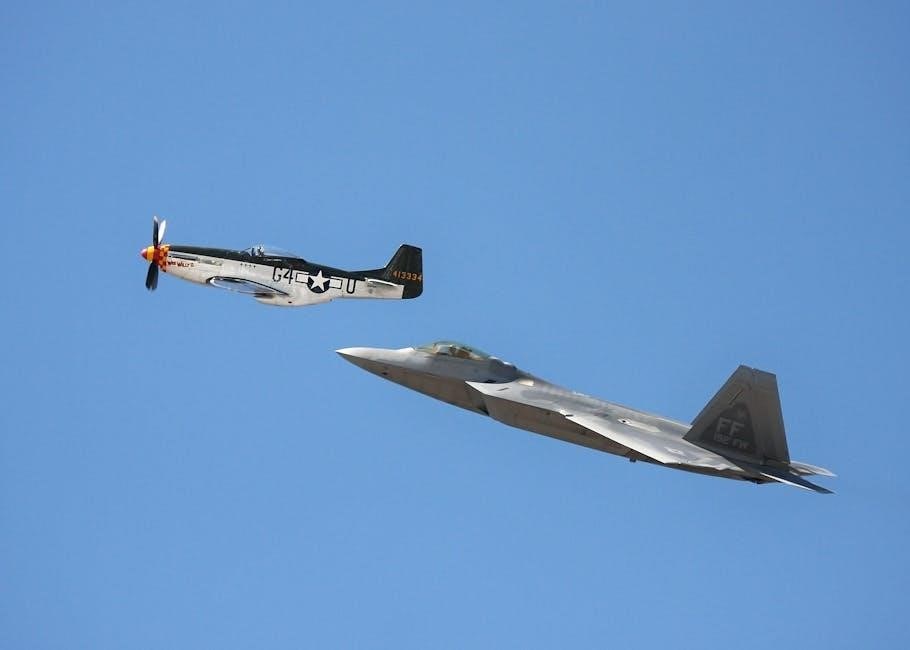Modern fighter aircraft are integrated weapons systems combining advanced avionics, stealth, and precision-guided munitions. They enable superior air-to-air and air-to-ground combat capabilities, ensuring dominance in contemporary warfare.
1;1 Evolution of Fighter Aircraft Weaponry
From basic machine guns to advanced missile systems, fighter aircraft weaponry has evolved significantly. Early planes relied on manual weapons, while modern jets employ guided missiles, smart bombs, and stealth technology. This progression reflects advancements in technology, emphasizing precision, range, and lethality to dominate air combat and ground missions effectively.
1.2 Purpose and Role of Modern Fighter Aircraft in Combat

Modern fighter aircraft serve as multirole platforms, excelling in air superiority, interception, and strike missions. They protect airspace, engage hostile aircraft, and support ground operations with precision-guided weapons. Their advanced sensors and stealth capabilities enable them to dominate both air-to-air and air-to-ground combat scenarios, ensuring tactical superiority in contemporary and future warfare environments.

Key Features of Modern Fighter Aircraft Weapons Systems
Modern fighter aircraft weapons systems emphasize advanced avionics, stealth technology, precision-guided munitions, and enhanced propulsion for superior combat performance and versatility in air-to-air and air-to-ground missions.
2.1 Avionics and Fire Control Systems
Modern avionics systems serve as the nervous system of fighter aircraft, integrating sensors, radars, and weaponry for seamless operation. Advanced fire control systems enable precise targeting, while AESA radars enhance threat detection. Real-time data processing and adaptive algorithms improve combat effectiveness, ensuring accurate missile launches and superior situational awareness in dynamic aerial engagements.
2.2 Stealth Technology and Its Impact on Weaponry
Stealth technology minimizes radar cross-sections, enabling fighter aircraft to evade detection. This enhances survivability and allows weapons systems to engage targets undetected. Advanced materials and designs reduce radar and infrared signatures, giving modern fighters a strategic edge in combat scenarios by enabling precise, long-range strikes and reducing vulnerability to enemy countermeasures.
2.3 Advanced Propulsion Systems for Enhanced Combat Performance
Modern fighter aircraft employ advanced propulsion systems, including thrust-vectoring nozzles and adaptive engines, to enhance maneuverability and range. These systems improve thrust-to-weight ratios, fuel efficiency, and reliability, enabling superior combat performance. Integration with avionics and weapons systems ensures seamless operation, optimizing the aircraft’s ability to execute high-intensity missions effectively.

Air-to-Air Missile Systems
Air-to-air missiles are critical for modern fighter aircraft, enabling engagements beyond visual range and in close combat. Advanced guidance systems enhance accuracy and lethality, ensuring superiority in aerial battles.
3.1 Beyond Visual Range (BVR) Missiles
Beyond Visual Range (BVR) missiles are advanced air-to-air weapons capable of engaging targets beyond the pilot’s visual range. Equipped with radar or infrared guidance, these missiles utilize cutting-edge avionics and fire control systems, enabling precise targeting and interception of enemy aircraft, even at extreme distances. Their integration into modern fighter jets ensures superior combat effectiveness and strategic advantage in aerial warfare.
3.2 Short-Range and Infrared-Guided Missiles
Short-range missiles excel in close combat, utilizing infrared guidance for precise targeting of enemy aircraft. These missiles, equipped with advanced seekers, effectively engage targets within visual range, ensuring rapid and decisive action in dogfighting scenarios. Their compact design and high maneuverability make them indispensable for modern fighter jets, enhancing combat effectiveness in dynamic aerial engagements.
3.4 Modern Countermeasures Against Air-to-Air Missiles
Modern countermeasures include chaff, flares, and advanced jamming systems to evade missile threats. Electronic counter-countermeasures (ECCM) enhance radar jamming resistance. These systems disrupt missile guidance, ensuring aircraft survivability. Additionally, integrated sensors and AI optimize countermeasure deployment, providing robust defenses against sophisticated air-to-air missiles in dynamic combat environments. These technologies are critical in maintaining air superiority and protecting fighter jets from missile attacks.
Air-to-Ground Weaponry
Modern fighter aircraft employ precision-guided munitions, cluster bombs, and laser/GPS-guided weapons for ground attacks. These systems enable accurate strikes, minimizing collateral damage and enhancing combat effectiveness in various theaters.

4.1 Precision-Guided Munitions (PGMs)
Precision-Guided Munitions (PGMs) are advanced air-to-ground weapons utilizing GPS, laser, or infrared guidance. These systems ensure high accuracy, reducing collateral damage and enhancing mission success. Modern PGMs integrate with fighter aircraft avionics, allowing real-time target updates and adaptable engagement strategies. Their effectiveness in diverse combat scenarios makes them indispensable in contemporary military operations, optimizing both lethality and operational efficiency significantly.
4.2 Cluster Munitions and Their Modern Applications
Cluster munitions are air-to-ground weapons dispersing multiple submunitions over wide areas. Modern applications emphasize precision and reduced collateral damage through advanced fusing and targeting systems. Despite controversies, they remain effective against large or dispersed targets, with ongoing developments focusing on enhancing reliability and minimizing unexploded ordnance risks in contemporary military operations and tactical scenarios.
4.3 Laser-Guided and GPS-Guided Bombs
Laser-guided bombs use precise laser targeting for high accuracy, minimizing collateral damage. GPS-guided bombs employ satellite navigation for pinpoint strikes in various weather conditions. Both technologies enhance operational effectiveness, enabling modern fighter aircraft to deliver munitions with exceptional reliability and lethality, critical in contemporary air-to-ground missions and asymmetric warfare scenarios.

Advanced Sensors and Radar Systems
Modern fighter aircraft employ cutting-edge sensors and radar systems, including AESA and IRST, enhancing target detection, tracking, and combat effectiveness in complex aerial environments.
5.1 Active Electronically Scanned Array (AESA) Radars
AESA radars revolutionize combat capabilities with advanced beam steering and multi-target tracking. They enhance situational awareness, resist jamming, and enable simultaneous air-to-air and air-to-ground operations, critical for modern fighter aircraft superiority.
5.2 Infrared Search and Track (IRST) Systems
IRST systems enhance passive detection of enemy aircraft and missiles, operating independently of radar emissions. They provide real-time thermal imaging, improving situational awareness and resistance to electronic countermeasures. Modern IRST systems integrate with AESA radars, enabling precise targeting and threat tracking, while supporting evasive maneuvers in hostile environments, making them indispensable in contemporary aerial combat scenarios.
5.3 Integration of Sensors for Target Detection and Tracking
Modern fighter jets employ integrated sensor systems, combining AESA radars, IRST, and electronic warfare suites. This fusion enhances target detection, tracking, and engagement, enabling seamless operation in contested environments. Real-time data sharing improves situational awareness, allowing pilots to respond swiftly and accurately, ensuring superior combat effectiveness in dynamic aerial warfare scenarios.
Electronic Warfare and Countermeasures
Modern fighter jets employ advanced electronic warfare systems to disrupt enemy radar and communications. Chaff, flares, and ECCM ensure survivability, while cyber warfare capabilities expand tactical options.
6.1 Radar Jamming and Electronic Counter-Countermeasures (ECCM)
Radar jamming disrupts enemy radar systems, reducing their effectiveness in detecting or tracking friendly aircraft. ECCM enhances resilience by countering enemy attempts to interfere with friendly radar. Modern ECCM employs advanced signal processing, adaptive filtering, and encryption to maintain operational effectiveness. These systems ensure uninterrupted radar functionality, enabling fighters to dominate air-to-air combat scenarios and maintain situational awareness in contested environments.
6.2 Chaff, Flares, and Other Countermeasure Systems
Chaff and flares are critical countermeasures against missile threats. Chaff disperses clouds of reflective material to saturate enemy radars, while flares emit intense infrared signatures to decoy heat-seeking missiles. Modern systems deploy these measures automatically, using threat detection algorithms to optimize effectiveness. Additional countermeasures include directional infrared countermeasures and towed decoys, enhancing aircraft survivability in hostile environments.
6.3 Cyber Warfare in Modern Aerial Combat
Cyber warfare plays a pivotal role in modern aerial combat, enabling disruption of enemy sensors, communications, and command systems. Advanced electronic countermeasures (ECM) and network-centric warfare capabilities allow fighter aircraft to degrade adversary systems. Integration of artificial intelligence enhances real-time decision-making, while secure communication networks ensure robust command and control. Modern fighters like the F-22 and F-35 leverage cyber capabilities to dominate the electromagnetic spectrum.
Modern Fighter Aircraft Examples
Modern fighter aircraft like the F-22 Raptor, F-35 Lightning II, and Russian Su-57 dominate air combat with advanced avionics, stealth, and precision-guided weaponry.
7.1 F-22 Raptor and Its Weaponry
The F-22 Raptor is a fifth-generation stealth fighter equipped with advanced avionics and weaponry. It carries AIM-120 AMRAAM missiles for BVR combat and AIM-9X Sidewinders for close-range engagements. The aircraft’s internal weapons bays house precision-guided munitions, minimizing radar cross-section. Its integrated systems enable unparalleled combat effectiveness, making it a benchmark in modern air superiority.
7.2 F-35 Lightning II and Its Multirole Capabilities
The F-35 Lightning II is a fifth-generation multirole fighter, excelling in air-to-air and air-to-ground missions. It carries AIM-120 AMRAAM and AIM-9X Sidewinder missiles for air combat, along with precision-guided bombs like the GBU-12 and GBU-49. Its advanced avionics, stealth design, and network-centric capabilities enable seamless integration with allied forces, making it a versatile and dominant force in modern combat scenarios.
7.3 Russian and Chinese Fighter Aircraft Developments
Russia’s Su-57 and China’s J-20 are fifth-generation stealth fighters, equipped with advanced missiles and sensors. The Su-57 carries hypersonic Kinzhal missiles, while the J-20 integrates PL-15 long-range missiles. Both aircraft feature avionics and radar systems for superior situational awareness, reflecting their nations’ focus on modernizing air forces to counter global threats and maintain strategic air superiority in future conflicts effectively.

Future Trends in Fighter Aircraft Weaponry
Future trends include hypersonic weapons, directed energy systems, and AI-driven targeting. These technologies enhance combat performance and survivability, shaping next-gen fighter capabilities for advanced aerial dominance.
8.1 Hypersonic Weapons and Their Integration
Hypersonic weapons, capable of exceeding Mach 5, are being integrated into modern fighter aircraft for precision strikes. These systems reduce enemy reaction time and enhance lethality. Current developments include air-launched hypersonic missiles like the Long-Range Standoff (LRSO) and next-gen interceptors. Integration with advanced avionics ensures seamless targeting and deployment, making hypersonic weapons a game-changer for future air superiority and strategic missions.
8.2 Directed Energy Weapons (Laser and Microwave)
Directed energy weapons, including lasers and microwaves, are revolutionizing modern fighter aircraft arsenals. These systems counter missiles and enemy aircraft with precision and unlimited magazine capacity. High-energy lasers disrupt targets, while microwaves disable electronics. Integration with stealth technology enhances their effectiveness, offering a next-gen defense solution for air superiority and reducing reliance on traditional munitions in future combat scenarios.
8.3 Artificial Intelligence in Weapons Systems
Artificial Intelligence (AI) is transforming modern fighter aircraft weaponry by enhancing decision-making and precision. AI algorithms process real-time data, enabling faster target detection and adaptive tactics. Advanced systems like those in the F-35 and F-22 integrate AI for smarter threat responses, while future applications may include autonomous weapons systems capable of independent decision-making, revolutionizing aerial combat dynamics and accuracy in engagements.
Modern fighter aircraft weapons have revolutionized combat through advanced precision, stealth, and AI integration, continuously enhancing combat effectiveness and shaping the future of aerial warfare and capabilities.
9.1 Summary of Modern Fighter Aircraft Weaponry
Modern fighter aircraft weaponry encompasses advanced systems like precision-guided munitions, beyond visual range missiles, and stealth technology. These innovations enhance combat efficiency, enabling superior air dominance and versatile mission capabilities, while integrating cutting-edge sensors and electronic warfare tools ensures adaptability in evolving battlefield scenarios, as detailed in comprehensive resources like Weapons of War Modern Fighter Aircraft 1945-Present and The Encyclopedia of Modern Military Weapons.
9.2 Future Outlook and Potential Developments
Future advancements in fighter aircraft weaponry will focus on hypersonic systems, directed energy weapons, and AI-driven technologies. These innovations aim to enhance speed, precision, and adaptability in combat. Integrating next-gen sensors and autonomous systems will redefine aerial warfare, ensuring superior capabilities for upcoming challenges, as explored in resources like Modern Fighter Aircraft Technology and Tactics and The Encyclopedia of Modern Military Weapons.

References and Further Reading
Key resources include The Encyclopedia of Modern Military Weapons and Modern Fighter Aircraft Technology and Tactics, offering detailed insights into advanced weaponry and systems.
10.1 Recommended PDF Resources on Fighter Aircraft Weapons
Key PDF resources include The Encyclopedia of Modern Military Weapons and Modern Fighter Aircraft Technology and Tactics. These documents provide detailed insights into advanced weaponry, including air-to-air missiles, precision-guided munitions, and stealth technologies. Additionally, Weapons of War: Modern Fighter Aircraft 1945-Present offers comprehensive coverage of historical and contemporary systems, available for free download.
10.2 Academic and Military Publications
Academic and military publications, such as Janes Armoured Fighting Vehicle Retrofit Systems and ENCYCLOPEDIA OF MODERN U.S. MILITARY WEAPONS, provide in-depth analysis of modern fighter aircraft weaponry. These resources cover advancements in stealth technology, missile systems, and combat tactics, offering insights into the evolving nature of aerial warfare and the integration of advanced weapon systems in military operations.
10.3 Online Databases and Encyclopedia Entries
Online databases and encyclopedias, such as Weapons of War: Modern Fighter Aircraft 1945-Present and The Complete Book of Fighters, offer comprehensive insights into modern fighter aircraft weaponry. These resources detail advanced missile systems, stealth technologies, and precision-guided munitions, providing a wealth of information on aerial combat capabilities and their evolution over time.

